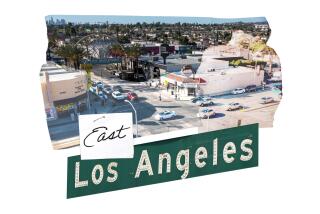Chamber Has a Strategy for Easing the Struggle
- Share via
When a think tank produced a list of American cities saddled with the most “urban hardship,” it was no surprise that Los Angeles showed up next to gritty metropolises like Newark, Detroit and Cleveland.
But eyebrows arched when the ranking last fall was led by a city in largely suburban Orange County -- Santa Ana.
The Nelson A. Rockefeller Institute of Government compared the 86 largest cities based on unemployment, dependency, education, income, crowded housing and residents living below the poverty line. In housing, income and education, Santa Ana’s marks were worse than any other city and roughly double those for Los Angeles.
In the nine months since, the Orange County seat has seen a flurry of impressive development planning.
Voters approved a 37-story office tower that could change the face of downtown by 2008. And city officials won a new $17-million home for the state’s 4th District Court of Appeal, beating out UC Irvine.
Yet the problems outlined by the Rockefeller Institute are no less present in a city where a significant population of low-paid immigrants are crammed into small apartments with high rents.
Fifty-three percent of the population was born outside the United States, the fourth-highest percentage of any U.S. city with a population of 100,000 or more. The list was topped by Hialeah, Fla.; Miami; and Glendale.
Seventy-seven percent of residents are Latino, and although the California Department of Finance estimated Santa Ana’s 2004 population at 349,100, some experts believe that uncounted illegal immigrants could bring the total closer to half a million.
There has been little public discussion about solving the crowding and poverty. But at the Santa Ana Chamber of Commerce, President and Chief Executive Michael Metzler used the findings to develop the chamber’s five-year strategy.
With a vested interest in the city’s long-term economic health, the business group often weighs in on municipal budget matters.
Metzler has led a school district bond oversight committee, and he talks regularly with City Manager David N. Ream and Mayor Miguel A. Pulido.
But in a recent interview, the chamber chief demonstrated that he doesn’t always agree with city government’s approach to solving problems.
Question: What has been the reaction to the Rockefeller Institute study?
Answer: Metzler acknowledged that issues of poverty and the lack of English competency were not often mentioned in City Council meetings or even individually by public officials. But he said the report was a wake-up call for the chamber, which wants to focus on getting more English instruction and job training to the low-income population.
“Rather than ignore that problem, we need to take it head-on,” Metzler said.
Q: How should the city tackle problems that contributed to Santa Ana’s hardship rank, such as overcrowding and high rents?
A: Metzler advocates looking at businesses that will probably grow, figuring out what training employees need and working to get it to potential workers. He is also concerned that so many people in Santa Ana struggle with English.
The chamber is working with the Rancho Santiago Community College District, serving central Orange County, to create a “Marshall Plan” that would identify and assist students who need language help. The costs have not been determined yet, but money would be raised from partners including businesses and government entities such as the college.
The chamber also wants to create a charter technical high school in Santa Ana where students would focus half the day on regular schoolwork, and in the afternoon develop technical skills that local businesses could use.
Officials are also discussing a first-time home buyer program with a local financial institution and exploring the concept of employer-assisted housing.
“We are doing this because we care about our people but we also care about economic prosperity. If we don’t proactively change the per capita income average of our population, we are destined to become a ghetto,” Metzler said.
Q: What can be done to reduce overcrowding?
A: In many city supermarkets, customers post makeshift signs advertising rooms for rent. It is not uncommon for rooms to be shared by families of three or more. Metzler said the state simply did not provide enough incentive for builders to offer more affordable housing. Soon, his group will join nine other chambers to lobby state lawmakers for help in dealing with the housing crisis.
They also want the state to create tax incentives for developers and housing allowances for first-time home buyers.
Q: How does the city attract and retain businesses when its image is tarnished?
A: Metzler said Santa Ana has not had trouble attracting businesses in the last five years. Some have relocated from nearby Irvine, on the city’s southwest border, because Santa Ana has better access to freeways and an available workforce. The city’s federally designated enterprise zone has been a draw because companies that locate there can get a tax credit for employees who meet any one of 13 criteria. If the companies owe taxes, the credits can be used against their tax debt.
Q: What do you say to those longtime residents who suggest that Santa Ana’s economic health will never improve until its racial demographics change?
A: Metzler said the only demographic that needed to change was income, and that would be done by providing jobs. More middle-class people mean a larger tax base, more steady consumers and more opportunities for business development, he said.
Q: What should the city be doing to improve itself?
A: Metzler believes that the seven council members have a sense of what they want the city to become, but they have yet to define a plan.
“The City Council must develop a vision and communicate that vision to the community, and then they must work with us and anybody else to go out and help people achieve this,” Metzler said. “It starts with a vision and the City Council does not have one. It’s more project-oriented, not community-oriented, and that needs to change.”
Q: Why was Santa Ana chosen over UC Irvine to be the site of the new appellate court building?
A: Santa Ana is already the county’s government center, with courts, a central jail and offices for the sheriff, the Board of Supervisors and a host of county services, Metzler said.
It also offered the state Judicial Council a 2.47-acre construction site for $1. Santa Ana “organized the community,” Metzler said, “not just government and business, but neighborhoods and civic groups en masse and presented our case as a whole.”
*
(BEGIN TEXT OF INFOBOX)
Urban hardship
The U.S. city with the highest hardship index -- which weighs factors such as unemployment, education, income and density --was Santa Ana, based on data from 2000.
Cities with most hardship, by index level
1. Santa Ana: 73.7
2. Miami: 71.6
3. Hartford, Conn.: 67.1
4. Newark, N.J.: 66.6
5. Gary, Ind.: 59.4
6. Detroit: 56.6
7. Cleveland: 55.8
8. Fresno: 54.4
9. Los Angeles: 51.0
10. Buffalo, N.Y.: 50.1
*
Santa Ana facts
The city’s median age of 26 is among the lowest of any large U.S. city.
Its average household is 4.6 people, greater than any U.S. city with a population of more than 50,000.
The city’s per capita income of $12,152 is less than half that of Orange County ($25,826) as a whole, and a little more than half that of Los Angeles County ($20,683).
Santa Ana is one of six large U.S. cities where foreign-born residents are the majority. Fifty-three percent of its population was born outside the United States.
The average rent on a two-bedroom apartment is $1,108 a month -- about the same as the average in Orange County. Average rental rate is projected to reach about $1,500 in Orange and Los Angeles counties this year.
Nearly 20% of residents live below the federal poverty level.
*
Source: The Nelson A. Rockefeller Institute of Government; Santa Ana; Census 2000; Lusk Center for Real Estate, USC. Graphics reporting by Jennifer Delson
Los Angeles Times
More to Read
Get the L.A. Times Politics newsletter
Deeply reported insights into legislation, politics and policy from Sacramento, Washington and beyond. In your inbox three times per week.
You may occasionally receive promotional content from the Los Angeles Times.










